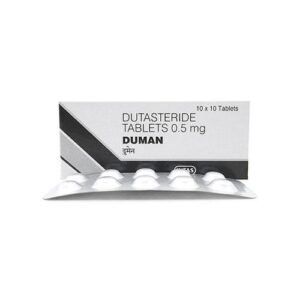DUTASETERIDE
DUTASETERIDE: Dutasteride is a medication used for the treatment of benign prostatic hyperplasia (BPH), which is the enlargement of the prostate gland in men. It is also sometimes prescribed off-label for the treatment of male-pattern hair loss (androgenetic alopecia).
The main mechanism of action of dutasteride is the inhibition of the enzyme 5-alpha-reductase, which converts testosterone to dihydrotestosterone (DHT). DHT is a potent androgen that is involved in the development and growth of the prostate gland. By inhibiting this conversion, dutasteride helps to decrease the size of the prostate and relieve symptoms associated with BPH, such as difficulty urinating, frequent urination, and weak urinary flow. For male-pattern hair loss, the reduction of DHT can slow down the progression of hair loss and promote hair regrowth.
The usual recommended dose of dutasteride for BPH is 0.5 mg taken once daily. For male-pattern hair loss, the recommended dose is also 0.5 mg taken once daily. It is important to take the medication as prescribed and follow the instructions provided by the healthcare professional.
As with any medication, dutasteride may cause side effects. Common side effects include decreased libido (sex drive), erectile dysfunction, ejaculation disorders, breast enlargement or tenderness, and dizziness. These side effects are usually temporary and may improve over time. However, if they persist or worsen, it is important to seek medical attention. Rare but serious side effects may include allergic reactions, liver problems, and depression or changes in mood.
It is worth noting that dutasteride is known to be teratogenic, meaning it can harm a developing fetus if taken by pregnant women. Therefore, women who are pregnant or planning to become pregnant should avoid handling crushed or broken tablets of dutasteride.
It is important to consult a healthcare professional for a complete list of side effects, drug interactions, and any other specific information related to the use of dutasteride.

